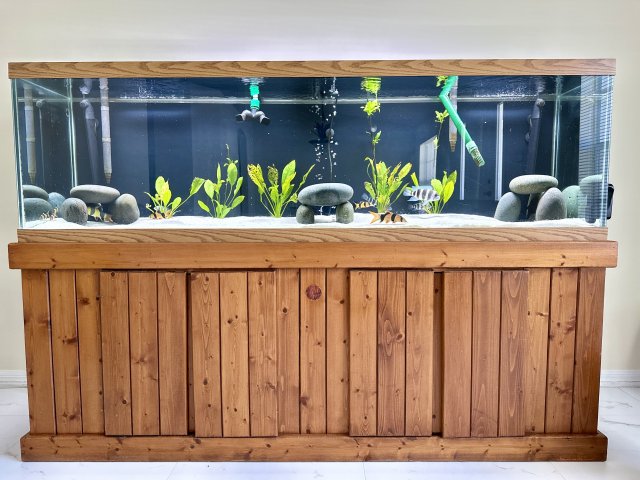My assumption is that should work, I usually consider about 2x manufacturers suggestion for filter capacity as a general sweet spot for my tanks, typically lightly to moderately stocked-- that's with cycled media. But I haven't had the FX filters, it's been mostly Eheims, so I don't know, really, and someone with real life FX6 experience could probably better answer that. Small frontosa are not especially hard on bio-load, they're not an especially active, fast growing fish that needs to eat a ton and really shouldn't be overfed.neutrino - I’ve got a fair amount of gear at this stage. Waiting on the delivery of the 210 Aqueon and pine stand sometime in July. I wanted to say thanks for the tips all the way along, it made it easier to plan for these fish and finalize exactly what I’ll be doing.
I found a source for WC Mpimbwe here in Canada - but they’re very pricy. Like $170 each. If I can find domestic Moba or something I might try and go in that direction instead to save some money.
I wanted to ask one further question. I picked up an FX-6 yesterday, and am eventually hoping to get a second for the tank. With just 5 or 6 small Frontosa in a 210, do you think I could get away with just a single FX-6 until I can grab a second on a Black Friday sale or something? Or would it be essential that I run two immediately?
I’m just trying to find ways to spread out some of the costs over time, rather than several large purchases all at once.
Calling all Frontosa keepers
- Thread starter Caperguy99
- Start date
You are using an out of date browser. It may not display this or other websites correctly.
You should upgrade or use an alternative browser.
You should upgrade or use an alternative browser.
Love my FX filters. I think 1 FX6 will be fine for quite awhile. When fish are full grown the second may be needed.
I agree with the responses above. I use FX4 and FX6 filters, in conjunction with sumps in my tanks.
Sorry to jump on this thread, but also looking into a frontosa colony and really appreciate the insight from here. I happen to have a Blue Zaire with the 180 gallon tank I bought, and now looking to acquire some similar fish at the 6 inches-ish range. Live near Seattle in USA. Anybody have trusted sources for such fish? Thanks in advance
Now that I have my setup nearly complete, I have a few last-minute questions. I’ve looked at older threads to try and find answers, but I figured I’d ask about the specifics.
When the fish arrive, they are going to be juveniles - around 2”. I’m going to feed them a varied diet - probably New Life Spectrum sinking pellets, frozen bloodworms, frozen brine shrimp, maybe some frozen krill chopped into small pieces.
Two questions:
- Is it true that I need to give them some sort of vegetable option once a week? If so, any recommendations?
- How much, physically, do I feed them? In terms of pellets - should each of them be getting 5-6 pellets once a day? I’m wary of over feeding, but don’t want to starve them either. Also, I want to make sure I’m giving them a good juvenile diet so that they grow nice and big.
Thanks so much!
I've personally never heard of any Frontosa plant-based food requirement. In regard to overfeeding and subsequent sub-par water quality, IME this is something that can creep up on you when doing grow-outs. Its a time when you need to be testing your water parameters more frequently for nitrate, and also other parameters depending on how long the tank's been running. Regarding the amount, I'd feed them multiple rather small feedings per day, making sure there's no leftover uneaten food.
I'm sure neutrino should be able to give you some good guidance here given his experience with Frontosa.
I'm sure neutrino should be able to give you some good guidance here given his experience with Frontosa.
Last edited:
I wonder why frontosa and clown loaches are such a common pairing. They seem to go well together
Sorry to jump on your thread OP. Following along as I plan a frontosa colony as well.
Last edited:
They go together like peanut butter and jelly ha.I wonder why frontosa and clown loaches are such a common pairing. They seem to go well together
Sorry to jump on your thread OP. Following along as I plan a frontosa colony as well.
Combination is up there with discus and neon tetras. I do find the clown loaches to be much more docile towards one another other than feeding times.
Kapampa are notoriously difficult to get breeding in captivity. I had a group of 9 without breeding success. I only know of a small handul of people who successfully bred this variant in the US. Not sure why so, but alas it is trueThese were wild caught Kapampa in a 135 gallon that never did spawn for me.
View attachment 1537710



